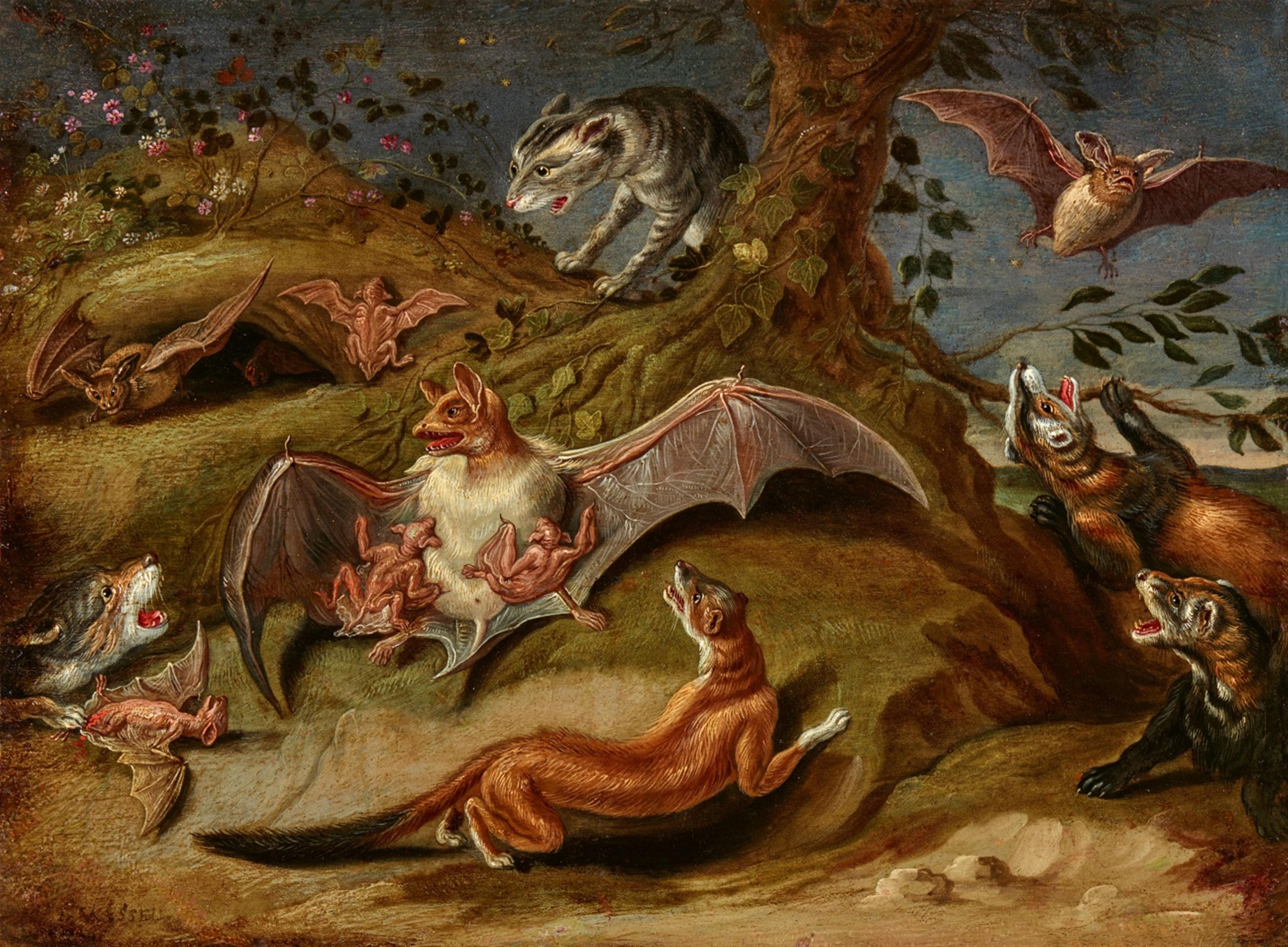Jan van Kessel the Elder
Allegory of Night
Oil on copper, mounted on panel. 17 x 23 cm.
Signed lower left: I. VKESSEL (VK conjoined).
This finely painted and well preserved copper panel by Jan van Kessel is unusual for two reasons: For one, it shows an iconographically noteworthy depiction of a nocturnal battle between bats, weasels, and cats. It also depicts bats not with the negative connotations with which they are usually associated in art, but instead in the role of heroic protagonists. The battle on the forest floor takes place at nightfall at the foot of a tree in the manner of a sous-bois still life. In the centre we see a bat with wings outstretched defending itself from the attacking cats and weasels. One of the bats was able to escape, but one of the pups has fallen prey to a cat, and the two who are seen crawling from a hole in the ground will likely not survive, as we already see a further cat sneaking towards them.
Jan van Kessel masterfully displays a small group of animals engaged in a dramatic fight. The weasels and cats attacking from all sides form a ring around the bats in the centre, which gives the work an extraordinary sense of dynamism despite its small size.
In contrast to the art of east Asia, bats generally have a bad reputation in western tradition. They are primarily found among the hordes of demonic entities in depictions of the temptation of Saint Anthony or in allegories of night. This negative image is due only in part to their primarily nocturnal activity, but instead mainly arises from the fact that they cannot securely be allocated to any one genus. This was already noted by Aristotle and Pliny in antiquity: Bats are neither entirely avian nor entirely quadruped, but rather share qualities of both. They are able to fly, but seldom stray far from the earth below, they look similar to birds, but unlike them they have teeth and do not lay eggs, instead giving birth to pups and feeding them with milk. This unclear affiliation to any particular genus led bats to become associated with questionable character traits and ideas of moral flightiness. This is exemplified in Aesop's fable: A weasel who hated birds once attacked a bat, but when the bat explained to the weasel that it was not a bird, the attacker desisted. The bat was then attacked by another weasel that hated mice, at which point the bat proclaimed that it was a bird after all and flew away. The idea of the bat's unscrupulous character was applied to humans and remained alive well into the early modern era. In Florentius Schoonhoven's “Emblemata” of 1618, the bat from Aesop's fable reappears as the emblem entitled,
“to the flatterers” (ill. 2).
Aesop's fable demonstrates, bats and weasels were considered natural enemies since antiquity. Jan van Kessel illustrates this known animosity in his small panel, but goes against established artistic tradition by not depicting bats with the negative characteristics that they are usually assigned. This is especially clear in the depiction of the animal in the centre carrying two of its young. This detail is also observed from nature, as since Pliny's time bats have been known to carry their pups with them on their teats and suckle them in mid flight. The behaviour was also noted by Ulisse Aldrovandi, the most famous natural scientist of van Kessel's era, in his publication on birds in 1599 (fig. 1). The centre of the composition thus depicts a mother bat bravely defending her young against intruders. In this work it is the creeping cats and weasels with their elongated, serpentine bodies and twisting heads that take on a negative, adversarial role.
Two further depictions of fighting bats are known within Jan van Kessel's oeuvre, namely one in the Ashmolean Museum in Oxford and one in the Rijksmuseum Twenthe in Enschede. Ertz and Nitze-Ertz list both of these pieces among the allegories (Ertz/Nitze-Ertz 2012, no. 717, no. 720).
Certificate
Dr. Klaus Ertz, Lingen, 09. 02. 2016. - Dr. Walther Bernt, February 1979
Provenance
Collection, Baden-Wuerttemberg.

